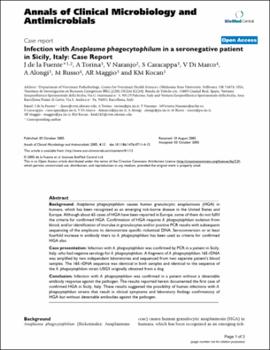| dc.contributor.author | de la Fuente, J. | |
| dc.contributor.author | Torina, A. | |
| dc.contributor.author | Naranjo, V. | |
| dc.contributor.author | Caracappa, S. | |
| dc.contributor.author | Di Marco, V. | |
| dc.contributor.author | Alongi, A. | |
| dc.contributor.author | Russo, M. | |
| dc.contributor.author | Maggio, A. R. | |
| dc.contributor.author | Kocan, K. M. | |
| dc.date.accessioned | 2015-10-16T20:48:24Z | |
| dc.date.available | 2015-10-16T20:48:24Z | |
| dc.date.issued | 2005-10-03 | |
| dc.identifier | okds_Kocan_ACMA_2005-10-03 | |
| dc.identifier.citation | de la Fuente, J., Torina, A., Naranjo, V., Caracappa, S., Di Marco, V., Alongi, A., Russo, M., Maggio, A. R., & Kocan, K. M. (2005). Infection with Anaplasma phagocytophilum in a seronegative patient in Sicily, Italy: Case report. Annals of Clinical Microbiology and Antimicrobials, 4, Article 15. https://doi.org/10.1186/1476-0711-4-15 | |
| dc.identifier.uri | https://hdl.handle.net/11244/19917 | |
| dc.description.abstract | Background: Anaplasma phagocytophilum causes human granulocytic anaplasmosis (HGA) in humans, which has been recognized as an emerging tick-borne disease in the United States and Europe. Although about 65 cases of HGA have been reported in Europe, some of them do not fulfill the criteria for confirmed HGA. Confirmation of HGA requires A. phagocytophilum isolation from blood, and/or identification of morulae in granulocytes and/or positive PCR results with subsequent sequencing of the amplicons to demonstrate specific rickettsial DNA. Seroconversion or at least fourfold increase in antibody titers to A. phagocytophilum has been used as criteria for confirmed HGA also. | |
| dc.description.abstract | Case presentation: Infection with A. phagocytophilum was confirmed by PCR in a patient in Sicily, Italy, who had negative serology for A. phagocytophilum. A fragment of A. phagocytophilum 16S rDNA was amplified by two independent laboratories and sequenced from two separate patient's blood samples. The 16S rDNA sequence was identical in both samples and identical to the sequence of the A. phagocytophilum strain USG3 originally obtained from a dog. | |
| dc.description.abstract | Conclusion: Infection with A. phagocytophilum was confirmed in a patient without a detectable antibody response against the pathogen. The results reported herein documented the first case of confirmed HGA in Sicily, Italy. These results suggested the possibility of human infections with A. phagocytophilum strains that result in clinical symptoms and laboratory findings confirmatory of HGA but without detectable antibodies against the pathogen. | |
| dc.format | application/pdf | |
| dc.language | en_US | |
| dc.publisher | BioMed Central | |
| dc.rights | This material has been previously published. In the Oklahoma State University Library's institutional repository this version is made available through the open access principles and the terms of agreement/consent between the author(s) and the publisher. The permission policy on the use, reproduction or distribution of the material falls under fair use for educational, scholarship, and research purposes. Contact Digital Resources and Discovery Services at lib-dls@okstate.edu or 405-744-9161 for further information. | |
| dc.title | Infection with Anaplasma phagocytophilum in a seronegative patient in Sicily, Italy: Case report | |
| osu.filename | okds_Kocan_ACMA_2005-10-03.pdf | |
| dc.description.peerreview | Peer reviewed | |
| dc.identifier.doi | 10.1186/1476-0711-4-15 | |
| dc.description.department | Veterinary Pathobiology | |
| dc.type.genre | Article | |
| dc.type.material | Text | |
| dc.subject.keywords | human granulocytic anaplasmosis | |
